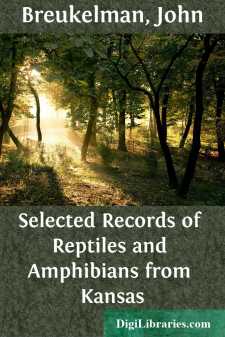Categories
- Antiques & Collectibles 13
- Architecture 36
- Art 48
- Bibles 22
- Biography & Autobiography 813
- Body, Mind & Spirit 142
- Business & Economics 28
- Children's Books 17
- Children's Fiction 14
- Computers 4
- Cooking 94
- Crafts & Hobbies 4
- Drama 346
- Education 46
- Family & Relationships 57
- Fiction 11829
- Games 19
- Gardening 17
- Health & Fitness 34
- History 1377
- House & Home 1
- Humor 147
- Juvenile Fiction 1873
- Juvenile Nonfiction 202
- Language Arts & Disciplines 88
- Law 16
- Literary Collections 686
- Literary Criticism 179
- Mathematics 13
- Medical 41
- Music 40
- Nature 179
- Non-Classifiable 1768
- Performing Arts 7
- Periodicals 1453
- Philosophy 64
- Photography 2
- Poetry 896
- Political Science 203
- Psychology 42
- Reference 154
- Religion 513
- Science 126
- Self-Help 84
- Social Science 81
- Sports & Recreation 34
- Study Aids 3
- Technology & Engineering 59
- Transportation 23
- Travel 463
- True Crime 29
Selected Records of Reptiles and Amphibians from Kansas
by: John Breukelman
Description:
Excerpt
Preparation of a handbook of reptiles and amphibians by the junior author has led to a survey of the collections of these animals at Kansas State Teachers College in Emporia. Numerous locality records of interest and importance have been accumulated there through the efforts of the senior author and a number of his students, particularly Mr. Allen Downs. The more important records, including the first record for Kansas of Rana sylvatica, are reported here. We have not mentioned specimens that are from counties from which the University of Kansas Museum of Natural History already has specimens.
Specimens examined by Smith are indicated by an asterisk; those identified by the late Dr. F. N. Blanchard are indicated by an encircled period (none of these specimens are now available). All other specimens here recorded have been examined either by the senior author or by Mr. Allen Downs, or by both. Specimen numbers, unless otherwise indicated, are those of the Kansas State Teachers College collection.
Triturus viridescens louisianensis (Wolterstorff), Newt.âCherokee Co.: 1 mile north and 4 miles east of Crestline (No. 164).* This is a terrestrial adult, and provides the second known locality for the species in the state.
Ambystoma texanum (Matthes), Narrow-mouthed Salamander.âLyon Co.: Emporia.
Ambystoma tigrinum mavortium (Baird), Tiger Salamander.âLyon Co.: (No. 292); 2 miles east of Americus. Ness Co.: Ness City (No. 591).
Scaphiopus bombifrons Cope, Plains Spadefoot.âNess Co.: 4 miles west, 1.5 miles north of Ness City (No. 592).
Bufo americanus americanus (Holbrook), American Toad.âChase Co.: 10 miles southwest of Saffordville. Cherokee Co.: 4 miles southeast of Columbus. Lyon Co.: 6 miles south of Plymouth (No. 290)*; Emporia (Nos. 442, 443).* The records from Chase and Lyon counties represent the westernmost localities for the species in Kansas.
Bufo cognatus Say, Great Plains Toad.âNess Co.: 4 miles west and 1.5 miles north of Ness City (No. 594).
Bufo woodhousii woodhousii (Girard), Rocky Mountain Toad.âClark Co.: 11 miles south of Bucklin (No. 401).* Decatur Co.: Sappa Creek near Oberlin (2 spec.).* Ford. Co.: 5 miles southwest of Dodge City (1 spec.).* Lyon Co.: Emporia (No. 352).* Ness Co.: Ness City (Nos. 502-504, 595, 596)*; 4 miles west, 1.5 miles north of Ness City (No. 593).* Sheridan Co.: Sheridan County State Park (Nos. 565-568).
Acris crepitans Baird, Northern Cricket Frog.âNess Co.: 4 miles west and 1.5 miles north of Ness City (Nos. 506, 507, 597-606).*
Pseudacris nigrita triseriata (Wied), Striped Chorus Frog.âLyon Co.: 10 miles south of Plymouth; 3 miles north of Emporia (No. 300); 7 miles west of Olpe; 2 miles northeast of Emporia (Nos. 434-441).* Neosho Co.: 3 miles west of Erie.
Hyla versicolor versicolor (Le Conte), Common Tree Toad.âChautauqua Co.: Elk City (No. 621).
Rana catesbeiana Shaw, Bullfrog.âNess Co.: 4 miles west and 1.5 miles north of Ness City (No. 607).* Wallace Co.: 3 miles east of Sharon Springs (1 spec.).*
Rana pipiens brachycephala Cope, Leopard Frog.âClark Co.: 11 miles south of Bucklin (Nos. 398-400).* Ness Co.: 4 miles west and 1.5 miles north of Ness City (Nos. 505, 508, 509, 608).*
Rana sylvatica cantabrigensis Baird, Wood Frog.âLyon Co.: extreme southwestern corner, 3 miles east of Chase County line, between the Verdigris River and the corner of the county (1 specimen, now Mus. Nat. Hist., Univ. Kans., No. 23149).* This specimen provides for the first time a basis for inclusion of the species in the fauna of Kansas. It measures 50 mm. snout to vent; hind leg from vent 80 mm.; tibia 23 mm. The ratio of hind leg to snout-vent measurement is 0.625, and that of the tibia to snout-vent measurement is 2.17....


